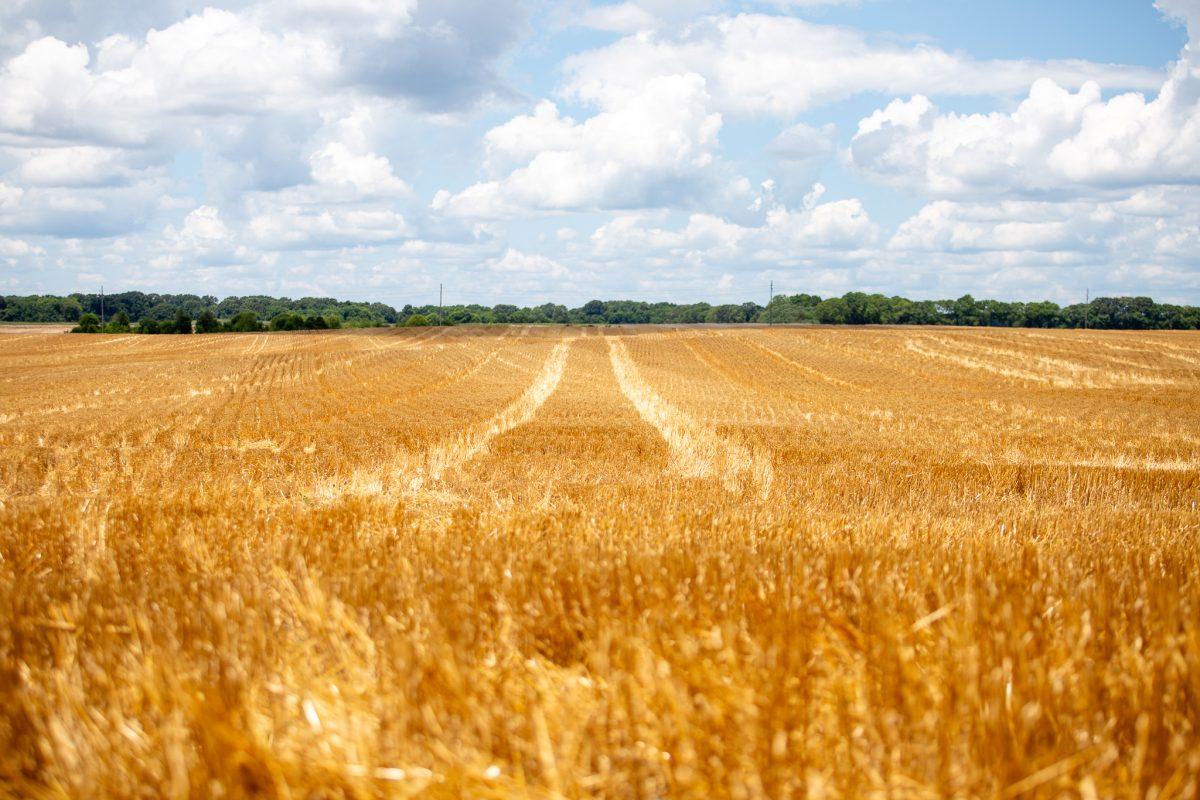The Mississippi Department of Agriculture and Commerce reported in 2022 that agriculture was the Magnolia State’s largest industry — outputting $9.72 billion through roughly 34,700 farms across 10.4 million acres.
At Mississippi State University, researchers have observed a shift in Mississippi’s climate and are investigating possible impacts on the state’s economic center. MSU assistant professor in agronomy Jagmandeep Dhillon said climate change has complex, interconnected impacts on agriculture.
“When we talk about climate change, it’s not one thing. It’s a lot of different things, and all of them are correlated,” Dhillon said. “Increase in temperature is going to affect precipitation. Effect on precipitation is going to affect your temperatures.”
Impacts on Crop Production
MSU assistant professor in agricultural climatology Prakash Jha said heat waves are one of the main threats crop farmers are facing in Mississippi. Temperatures and humidity have increased in recent years, and farmers are seeing above-average summer nighttime temperatures.
Jha said increased humidity and rising temperatures can cause disease in crops. Extreme heat can harm corn while it is in its silking stage, potentially causing the plant’s ears to rot. A poor corn harvest impacts livestock industries that use corn as feed.
Jha said Mississippi has seen a decrease in the number of days that frost occurs during the year, and that the first annual frost has shifted from mid to late October to early November. More frost-free days are better for summer crops that cannot withstand a freeze and provide these crops with a longer growing season. For winter crops that need colder weather, fewer days with frost can hurt production.
Overall, the increase in frost-free days has been beneficial to the Mississippi economy as the state relies more on the production of summer crops like corn, cotton and soybeans than it does on winter crops like lettuce and other leafy greens.
Raju Bheemanahalli Rangappa, an MSU assistant research professor in agronomy and plant stress physiology, said change in temperature or rainfall alone is not enough to significantly impact crops, but increasing temperatures coupled with a lack of rainfall can cause harmful effects on crop yields.
Bheemanahalli and other MSU researchers conducted multiple studies on how plants respond to changes in temperature and atmospheric carbon dioxide. Their research found that increasing daytime temperatures is detrimental to crops while increasing nighttime temperatures can be beneficial to crops.
Agronomist Dhillon said temperatures in Mississippi are not yet significantly harming the state’s crop production.
“Definitely, the way we are heading, it’s gonna be a huge negative impact, but when it’s gonna happen, that’s debatable,” Dhillon said. “What we have found: we are not there yet. Our temperatures haven’t hit that point after which it will be negative.”
Raja Reddy, an MSU research professor in agronomy and environmental plant physiology, said the temperature increase would have to be very large for there to be significant effects on global crop production. An increase of one degree Celsius would not cause much harm to crops. An increase of five degrees would be unbearable for most crops, but that is beyond what scientists are expecting by the end of the century.
Climatologist Jha said climate change is to blame for abnormal rainfall patterns in the Southern U.S. Lack of rainfall during certain parts of the growing season hinders crops from maturing properly, decreasing the quality of harvests. This is a growing problem in Mississippi, where farmers need regular rainfall to ensure high productivity.
“Proper distribution of rainfall helps in planning on field management strategy,” Jha said. “If you have enough information on rainfall, the next seven to ten days, you can plan on the field based on your disease management, on fertilizer, water management – anything.”
Reddy said variations in rainfall are a normal part of the Earth’s climate, but crops fare the worst whenever there is a lack of rainfall during their reproductive phase. For some crops like corn, the reproductive phase is short, about ten days. If there is not enough rainfall for the corn in those ten days, the plant will not reproduce properly.
Carbon Dioxide and Agriculture
At the center of the climate change discussion is carbon dioxide, the greenhouse gas whose concentration in our atmosphere has increased greatly in the last several decades. NASA reports that, in 1960, the amount of carbon dioxide in the atmosphere was just below 320 parts per million (ppm). As of September 2023, the amount is 419 ppm, a 30% increase.
Plant physiologist Reddy is the director of MSU’s Soil-Plant-Atmosphere-Research Facility. Reddy has done extensive research on how carbon dioxide concentration affects the production of different crops and said a greater concentration of carbon dioxide is not inherently bad for plants.
Agronomist Dhillon said carbon dioxide’s impacts differ depending on the crop.
“Carbon dioxide affects different crops differently depending on their physiology. For example, it’s gonna affect maize differently because it uses carbon more efficiently than some other crops say soybean or wheat,” Dhillon said.
Reddy said increasing levels of carbon dioxide can cause some plant varieties to produce more leaves and enhance their rate of photosynthesis. For leafy crops like lettuce, this can mean greater yields.
In 2022, Mississippi produced 29.5 million acres of sweet potatoes, making sweet potatoes the state’s ninth-largest agricultural commodity. Reddy performed an experiment where he grew sweet potatoes under two different concentrations of carbon dioxide (410 ppm and 760 ppm) and at different temperatures.
The study found that enhanced carbon dioxide levels increased the rate of photosynthesis and the area of leaves on sweet potato plants and that enhanced carbon dioxide levels could balance out some of the detrimental effects caused by higher temperatures and drought conditions.
Impacts on Beef Cattle Production
Brandi Karisch, MSU research professor in the Department of Animal and Dairy Sciences, said extreme weather events like droughts can be problematic for cattle producers, and that a current drought in Mississippi has had multiple impacts on livestock production.
“We’re not used to not having any rain, so from a livestock producer side of things, not only does that affect the grass that we grow for the cows to eat, but on top of that, it’s getting so harsh in some areas — where typically we would water some cattle out of ponds — in some areas, they’re having to haul water to cattle because ponds are drying up,” Karisch said.
Karisch said that during periods of heat stress, cows’ bodies will direct more blood flow into the cows’ extremities. For a pregnant cow, less blood flow will go toward the calf. As a result, the cow may give birth prematurely and the calf will be smaller.
Barbara Roqueta dos Reis is an assistant professor at MSU’s White Sands Unit, a research station in Pearl River County that specializes in beef cattle and pasture research. She said heat stress can decrease the quality of a cow’s milk as well as the number of immunity hormones that the cow passes to the calf through the milk. This lessened immunity transfer makes calves more vulnerable to disease.
Roqueta dos Reis said temperature extremes impact the quality of forage. Plants under high temperatures produce more cell walls within their cells. This increased amount of cell wall is harder for cattle to consume.
Adapting Agriculture
Organizations like the National Oceanic and Atmospheric Administration produce seasonal forecasts to inform farmers on what conditions will be like for the coming season. With this information, farmers change their planting strategies to cope with variations in weather patterns. Farmers plant crops earlier or later in the season depending on when the last frost occurs and how warm the soil is. They also may change how crops are placed to help the crops better withstand climate extremes.
Jha and his team at Mississippi State are developing an early warning system called the Mississippi System for Disease Early Warning. The system uses climate forecasts, remote sensing and crop models to predict the productivity of crops in an upcoming growing season. This information will be passed on to farmers who can use the information to create field-management strategies accordingly.
Jha said planting climate-resilient crops is one strategy farmers are using to face climate change. Drought-tolerant and heat-tolerant crops are being developed across the globe that can mature under abnormal conditions that would usually cause stress in plants.
Irrigation strategies can alleviate a lot of the detrimental effects posed by heat stress, but irrigation relies on the storage of groundwater beneath the earth’s surface. Climatologist Jha said Mississippi’s groundwater storage is becoming depleted due to increases in the amount of irrigation for crops like soybeans and cotton. The shortage of groundwater has become more pronounced in the last two decades.
Environmental Plant Physiologist Reddy said it takes a combination of new crop varieties and management strategies to adapt to a changing climate.
In livestock production, animals are being bred that are heartier to climate extremes. Karisch said many farmers own cattle with Bos Indicus influence, a species that is heartier to extreme heat and can handle increased amounts of parasites.
Roqueta dos Reis said artificial shades are often used to protect cattle from extreme heat in areas where there is less natural shade. She said that farmers also work their cows early in the morning to keep them from getting too hot.
Karisch said MSU recommends different water and pasture conservation strategies to maintain the quality of Mississippi’s pastures. These strategies can include rotational grazing, reducing the number of cows in a pasture and no-till seeding practices that maintain the soil’s integrity. Soil testing is also used to determine the kinds of nutrients present in the pasture.
Karisch said cattle farmers need to know how to produce grass for their animals.
“A lot of cattle producers really have to be grass farmers,” Karisch said, “and really take good care of the land so the land can kind of take care of their cattle and they can kind of take care of things that way.”
Agronomist Dhillon said that, so far, Mississippi agriculture has been able to avoid a lot of the negative impacts of climate change by using effective management strategies, but it is not a given that this trend will continue.
“Can we stay ahead of the curve?” Dhillon said. “That is what we are trying to do.”













